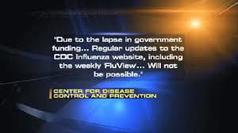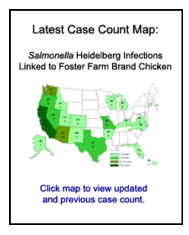|
|||||||||||||||||||||||||||||||||||||||||||||||||||||||||||||||||||||||||||||||||||||
From: "Centers for Disease Control and Prevention (CDC)" <[log in to unmask]>
Date: November 1, 2013 4:26:06 AM EDT
To: <[log in to unmask]>
Subject: Centers for Disease Control and Prevention (CDC) Daily Digest Bulletin

Health Communication Science Digest – October 2013 10/31/2013 Dear colleagues,
The October issue of Health Communication Science Digest (HCSD or Digest) is now available at http://www.cdc.gov/healthcommunication/ScienceDigest/index.html
This month we congratulate our CDC colleagues Tim McAfee, Robert L. Alexander, Jr., Terry F. Pechacek, and Rebecca Bunnell (all NCCDPHP/OSH) who are coauthors of the paper “Effect of the first federally funded US antismoking national media campaign” published in The Lancet.
Also in the Digest this month, there are several papers reporting public health communication interventions (Buhi, et al.; Flowers, et al.; Li, et al.; McAfee, et al.; Mullins, et al.) while others examine aspects of new media in health communication practice (Goldner, et al.; Junco; Naughton, et al.; Osatuyi; Purohit, et al.; Young, et al.). Health messaging considerations are highlighted in several studies (Cohen & Head; Gerrend & Shepherd; Jang, et al.O’Hara, et al.; Parvanta, et al.; Ramírez) while others explore health literacy (Shreffler-Grant, et al.). New idea for public health communication endeavors are also discussed (Guidotti).
Please remember that you can access all issues of the “Health Communication Science Digest” series online via the searchable Health Communication Science Digest Archive.
We hope that you find the Health Communication Science Digest useful and invite you to provide us with feedback for improvement. Please send us articles that you would like to share with others—articles you or your colleagues have published or found useful.
Please send your comments and questions to [log in to unmask].
We wish you much success in your public health work!
Dođan Erođlu
Associate Director for Communication Science
Office of the Associate Director for Communication
Centers for Disease Control and Prevention, Atlanta, GA
NCHS Data Briefs Update 10/31/2013 You are subscribed to receive email updates regarding NCHS Data Briefs from the National Center for Health Statistics, Centers for Disease Control and Prevention. The following reports have been added:
Data Brief No. 133. Hypertension Among Adults in the United States: National Health and Nutrition Examination Survey, 2011–2012
Hypertension is an important risk factor for cardiovascular disease and affects almost one-third of the U.S. adult population. In 2009–2010, nearly 82% of adults with hypertension were aware of their status, and nearly 76% were taking medication. Despite considerable improvement in increasing the awareness, treatment, and control of hypertension, undiagnosed and uncontrolled hypertension among minority groups remains a challenge. This report presents survey results for 2011–2012 on the prevalence, awareness, treatment, and control of hypertension.Have You Heard? Facts From The Field - October 31, 2013 10/31/2013
October 31, 2013
The Oklahoma State Department of Health’s chronic disease Toolkit Trilogy brings together data and evidence-based prevention strategies to help Oklahoma communities make decisions to improve health outcomes.
Using the toolkit, communities can
- Find out about cost savings from preventing hospitalizations [PDF - 6.8MB]
- Learn more about clinical and community prevention services [PDF - 374KB]
- View statewide data [PDF - 4.65MB] showing the connections between chronic disease and access to health care
Please share this e-mail with others interested in news and facts from the field. Past "Have You Heard? Facts From The Field" information is available online.
Provided by the
Office for State, Tribal, Local and Territorial Support
Centers for Disease Control and PreventionCheck out the CDC Genomics & Health Impact Weekly Update Oct 31: New features and 2 new blog posts! 10/31/2013

Having trouble viewing this email? View it as a Web page.
October 31, 2013 | Volume 31 Number 17
Features of the Week

Genomic Screening of Healthy Individuals? Not Yet

Public Health Genomics in Action: Familial Hypercholesterolemia

Sudden Death in the Young: Genomics & Public Health

Attention Deficit Hyperactivity Disorder: Genes & Environments

Amyotrophic Lateral Sclerosis: Baseball, Genomics & Public Health

Healthy Aging & Family History

Alzheimer's Disease & Genomics: New Insights

Sickle Cell Disease & Invasive Pneumococcal Disease

Stroke Awareness: Prevention, Family History & Genetics
Select Events
- Genomics Forum at the APHA Annual Meeting November 2-6, 2013, Boston MA
- Society for Epidemiologic Research 3rd Annual SERdigital Student Novel Methods Web Conference- Will genetics revolutionize public health? November 6, 2013, Webinar
- Genetics and Primary Care Institute: Genetics in Your Practice: Genetic Red Flags in Well-Checks, November 14, 2013, Webinar
Office of Public Health Genomics: http://www.cdc.gov/genomics
The Office of Public Health Genomics (OPHG) provides updated and credible information on how genomic information and family health history can improve health and influence policy and practice. We highlight news and information on the use of genomic tests and other applications, including family health history, in clinical and public health practice and programs, along with relevant data, policy, and legislation. We hope the update is informative to practitioners, policy makers, consumers, and researchers. Please send your comments to: [log in to unmask].
CDC Food Safety Update: September - October 10/31/2013
CDC & Food Safety
New reports, publications, and web material
September - October 2013
Absence Makes the Heart Grow Fonder


"Along with most of the federal government, the furlough curtailed the efforts of those who work to keep America healthy. For 16 days, there was a disturbing quiet in CDC’s offices, labs, and hallways. Our furloughed staff were forced to cancell meetings, trainings, and walk away from critical work battling food, water, and environmental diseases.
I was impressed by the dedication and commitment of the staff that stayed through the furlough, often doing the jobs of many others. And, I was impressed by the attitude of people after the furlough. You returned enthusiastically, picked up your work quickly, and moved forward. It is great to see and wonderful to feel that buzz of energy in our Division again.
I was not the only one who missed you. The media published a steady stream of news stories ranging from worry over gaps in surveillance for influenza and foodborne outbreaks to an article highlighting non-furloughed laboratory staff who quietly worked behind the scenes (photo on left: Dr. Collette Fitzgerald Leaumont, team lead, Enteric Reference Laboratory).
There is certainly nothing “non-essential” about our work.
Thank you and carry on."
~ Chris
Christopher R. Braden, M.D., CAPT USPHS

Outbreaks!
CDC tracked five multistate outbreaks of foodborne illness during September - October:
- Salmonella Heidelberg. In a multistate outbreak linked to Foster Farms brand chicken, seven outbreak strains of the bacteria Salmonella Heidelberg have sickened over 300 people—40% of whom were hospitalized.
- Vibrio parahaemolyticus. CDC and state and federal partners in 13 states are monitoring an increase in vibriosis since May 2013. Vibrio bacteria live in saltwater. People can get vibriosis after eating raw or undercooked shellfish, particularly oysters. Several species of Vibrio, including Vibrio parahaemolyticus, can cause illness.
- Cyclospora. An Outbreak of Cyclosporiasis in the United States appears to be over.*
- Hepatitis A. The multistate outbreak of hepatitis A linked to pomegranate seeds from Turkey** appears to be over.
- Listeria. An outbreak strain of Listeria monocytogenes linked to Crave Brothers cheeses, appears to be over.
* This outbreak falls under the jurisdiction of CDC's Division of Parasitic Diseases and Malaria. ** This outbreak falls under the jurisdiction of CDC's Division of Viral Hepatitis.
Select CDC Food Safety Publications
Key CDC publications during September - October include:

Antibiotic Resistance Threats Report and Foodborne Germs
- Each year, millions of people in the United States become sick from foodborne and other enteric (gastrointestinal) infections. While many of these infections are mild and do not require treatment, antibiotics can be lifesaving in severe infections. Antibiotic resistance compromises our ability to treat these infections and is a serious threat to public health. CDC’s Antibiotic Resistance Threats in the United States, 2013 report [PDF - 76 pages] connects antibiotic resistance to foodborne and other enteric germs in animals, food, and humans.
Food Safety
- Over half of all foodborne disease outbreaks reported to the CDC are associated with eating in restaurants or delicatessens. Using data on restaurant-associated foodborne disease outbreaks reported by sites participating in the Foodborne Diseases Active Surveillance Network (FoodNet), CDC analysts characterized contributing factors and the levels of evidence used to determine them.
- Gould LH, Rosenblum I, Nicholas D, Phan Q, and Jones TF. Contributing Factors in Restaurant-Associated Foodborne Disease Outbreaks, FoodNet Sites, 2006-2007. Journal of Food Protection, Vol. 76, No. 11, 2013, Pages 1824–1828, doi:10.4315/0362-028X.JFP-13-037.
On the Web
Voluntary Guidelines for Food Establishments during a Foodborne Illness Outbreak Investigation
CIFOR--the Council to Improve Foodborne Outbreak Response-is a partnership of food industry and public health professionals working to reduce the burden of foodborne illness in the United States.
CIFOR's Guidelines for Foodborne Outbreak and Response (2009-2012) are recommendations for owners, operators, and managers of retail food establishments during a foodborne illness outbreak investigation. The document provides step-by-step approaches to outbreak response.
Modify/Update Subscriber Preferences | Unsubscribe | Send Feedback | Learn more about CDC Email Updates
To receive the latest news for your region, please update your profile with your country, state and zip code.
Questions or problems? Please contact [log in to unmask].
STAY CONNECTED: CDC on Facebook Dr. Frieden on Twitter CDC on YouTube
This email was sent to [log in to unmask] using GovDelivery, on behalf of: Centers for Disease Control and Prevention (CDC) · 1600 Clifton Rd · Atlanta, GA 30333 · 1-800-CDC-INFO (800-232-4636)
To unsubscribe from the NFS-L list, click the following link:
&*TICKET_URL(NFS-L,SIGNOFF);